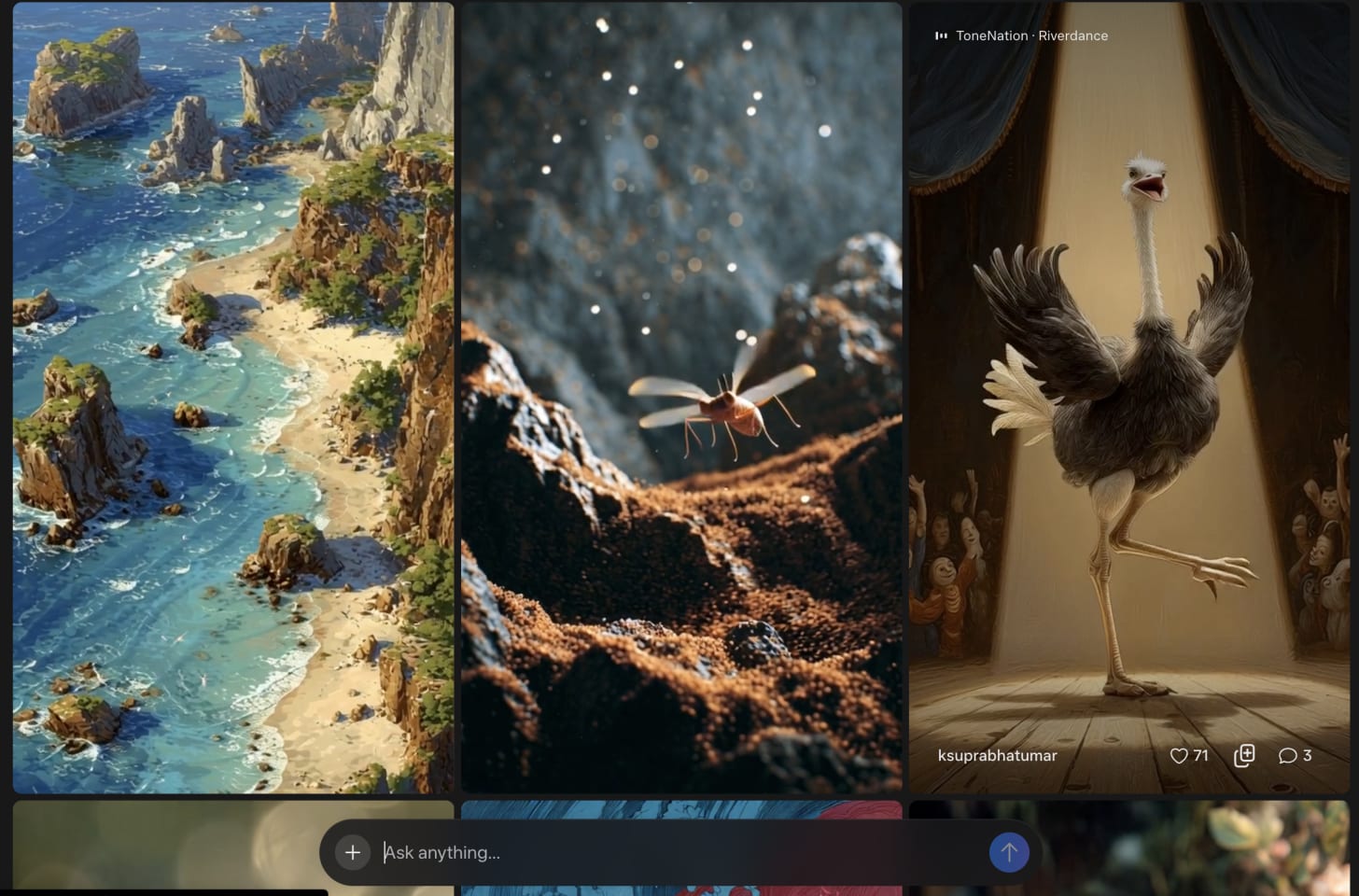Disclaimer: The opinions stated here are my own, not necessarily those of my employer.
Meta recently announced Vibes, a new short-form AI-generated video feed on meta.ai. The top comment, which ratio’ed the announcement post, said : “should’ve called it Trough, the kind pigs eat their slop out of”. Despite finding this hilarious, I decided to spend some time consuming content on the new feed (meta.ai/discover) and record my experience, instead of directly joining the chorus against it.
My truth-seeking exercise didn’t last very long; after about five minutes, I concluded that it really was unbearable AI slop (here’s Simon Willison defining slop). At the risk of generalizing too broadly, I do think most users felt the same way. But instead of piling on the content itself, I got curious about the why. Why can’t we stand AI slop? Why can’t we stand watching an aproned cat carefully stirring compote? What’s not to like about a capuchin monkey having fun on a jet-ski?
As an early thought exercise, I put myself in the shoes of the team that convinced themselves and everyone else that launching this feed was a good idea. Surely, someone would’ve asked: “This is unwatchable. Why would you want to launch it?!”
Here’s a reasonable response:
“We think the biggest reason is because the feed isn’t personalized yet. We have followup launches that will rank content based on the user’s Insta & FB interest profiles. We are already seeing higher engagement and better feedback from early A/B tests.”
Let’s get this factor out of the way so we can go deeper into why AI slop is unbearable. Instead of the current version of Vibes, imagine a fully personalized feed, full of AI-generated videos that are relevant to your interests. You can easily simulate this world by looking at your YT shorts/Tiktok feed and generating the same videos with any of the SOTA models that are available (Veo, Sora, etc). Do you like what you see now?
If your answer is still “No”, a large factor could be the quality of these videos. Although video generation models have improved at a breathtaking, exponential rate over the past couple of years, they’re still not quite there yet. Our emotional response to content that is “not quite there yet” cannot be overstated. The “uncanny valley”, which was originally about the eerie feeling associated with near-human robots, applies to AI-generated content that is almost real, but not quite there yet.
Our brains process billions of images of the real world every minute, which makes them sensitive to even the smallest deviations from their perceived reality. An hour long video that lacks continuity for only a few seconds will still feel extremely jarring. Temporal inconsistency, not obeying the laws of physics, such as how shadows are formed, and anatomical hallucinations are all common issues.
What if we controlled for this variable too? It’s not unreasonable to assume that the remaining gaps in video generation quality will be closed within the next few years. We are already seeing AI-generated videos that cannot be distinguished from real videos by most humans. Then, let’s go back to our original thought exercise with a refined question.
If your answer is still “No”, it’s time to go deeper into more subjective and murky variables.
Let’s start with the example of Chess, which is interesting as an analogy for two reasons:
(1) Computers started defeating human grandmasters over thirty years ago. Chess engines have gotten even better since then, to the point where a program small enough to be loaded onto your iPhone can defeat the greatest chess player of all time.
(2) Chess is more popular now than ever as a spectator sport. Since the pandemic, the numbers of both viewers and amateur players have gone up exponentially. Thanks to Chess.com, Twitch and Youtube, there is a massive ecosystem of creators and sponsors, making Chess more lucrative than ever.
![r/dataisbeautiful - [OC] AI vs human chess Elo ratings over time r/dataisbeautiful - [OC] AI vs human chess Elo ratings over time](https://substackcdn.com/image/fetch/%24s_!37Jl!,w_1456,c_limit,f_auto,q_auto:good,fl_progressive:steep/https%3A%2F%2Fsubstack-post-media.s3.amazonaws.com%2Fpublic%2Fimages%2F63fbac43-7976-4341-bc65-68e96095e1c1_640x640.png)
If we combine these two points and apply all the hot takes from LinkedIn that talk about how profession X is dead because AI can now do X, then the whole world must be watching Stockfish v AlphaZero (the best chess engines). But the whole world is still watching Magnus v Hikaru (the best human players) and very few people care about engines playing each other.
Maybe the main purpose of Chess, as we currently perceive it, is to push the boundaries of human memory, focus, and creativity (with emphasis on “human”)? The moment another form of intelligence is introduced, with a different set of constraints, that very purpose is lost. Instead of replacing human players, engines are being used to augment human chess skills. Simulated practice opponents and game analyses using engines have become universally available, to the point where the current crop of advanced chess players, would easily defeat any of their preceding generations if they faced off against each other.
Another reason for the surge in the popularity of Chess has been the access people get to top level players. When fans watch Magnus v Hikaru, they aren’t just thinking about the pieces on the board. They are thinking about the illustrious rivalry between the two. They are thinking about the contrast in their personalities, their mutual respect for each other, the last interviews they gave about each other. Fans are watching Magnus the personality v Hikaru the personality. This is what makes their game, the content, truly interesting.
Obviously, content creation is not the same as Chess. But there are some transferrable lessons:
Firstly, I believe human effort and the application of human skill will always matter. Person A spends several hours each day creating a Rube Goldberg machine and makes a video showing their final contraption in action. Person B prompts “create a video of a Rube Goldberg machine that lasts 30s” and makes a similar video. Their outputs might look the same, but a part of us cares more about the inputs and the process. A feed full of AI-generated videos is devoid of “real” human effort, which might make us want to devote lesser time to it. It also begs the question of “so what?”.
Secondly, the human story behind a creator matters almost as much as their creation itself. When we consume content or any form of art, we attempt to understand the creator’s state of mind. Their story, their personality, their shortcomings and their gifts — all of these things play a role in the amount of attention we choose to give them (see Theory of Mind). Any creation that misses these ingredients, be it human or AI-generated, might be called soulless. Soulless creations might grab your attention for a short period of time, but they are unlikely to sustain your interest.
However, these lessons may not hold true in a completely different context that gets created in the future. Maybe we will start anthropomorphizing AI models and attach human stories to them. Maybe Gen Alpha and future generations that are attuned to AI-generated content from the very beginning will see this world very differently. In any case, the one thing we know for sure is that content consumption has already changed forever.
What would users value when there are no barriers to content creation? Will “human-generated” content become a premium commodity? These are fascinating questions that need answering; and hopefully the new Vibes feed will serve us some answers, along with the slop.
Disclaimer: The opinions stated here are my own, not necessarily those of my employer.
.png)





